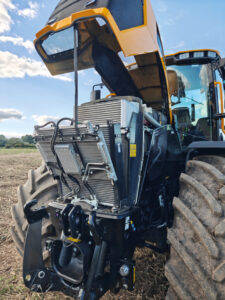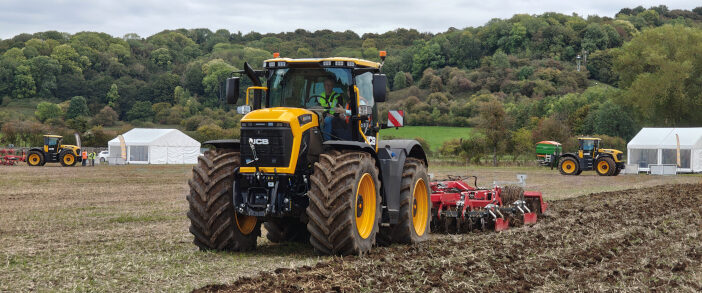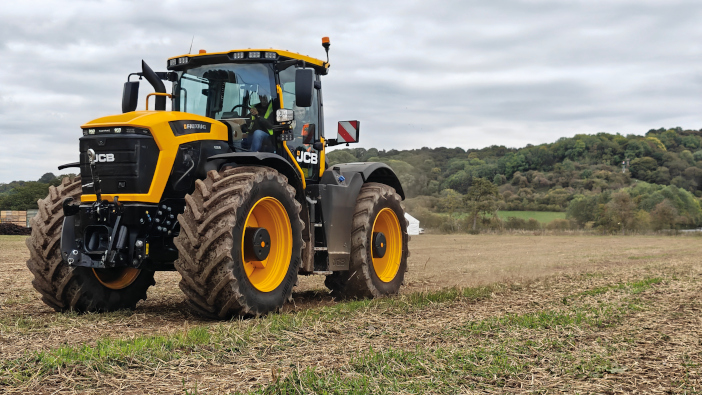Recognising the need for a high-horsepower tractor range that retains the manoeuvrability and high-speed capabilities of its smallest series, JCB has introduced the Fastrac 6000
At the JCB World Headquarters in Uttoxeter, John Smith, managing director of JCB Agriculture, acknowledged that the agricultural market was changing. “We’re seeing a structural shift in the tractor market, particularly, where the overall volume of machines sold is down, but the average horsepower continues to rise.”
The need for greater horsepower coincides with farms consolidating and becoming larger, with increased distances between fields. Recognising a need to revamp its tractor lineup to meet these demands, JCB has spent five years working on a ground-up project, filling the gap between its 4000 iCON and 8000 iCON series.
Greg Fitton, manager of global Fastrac sales, says: “Customers really like the compact size of the 4000 and the four-wheel steering, but wanted more power than the 240hp it could provide. At the same time, the 8000 iCON was too large for some operations.”
The resulting two-model Fastrac 6000 offers max power outputs of 284hp or 335hp – a significant crossover into the 8000’s power bracket that suggests the next step will be to boost the flagship range. This is produced by an FPT 6.7-litre engine with a torque curve that maxes out at 1,275Nm on the 6260 and 1,400Nm on the 6300.
A key reason for switching over to FPT from the Agco Power units used in the 4000 and 8000 models was the narrow engine design, according to Robin Carter, chief engineer. Similarly, the company has shifted from the Agco-built Vario transmission to a ZF continuously variable Eccom 3.1 box, with four automated ranges; a setup that reportedly suits the JCB approach.
High-speed operation remains a key selling point to the machine, and the 6000 sits neatly between the 4000 and 8000 with a 66kph top road speed, with full ABS braking with external discs to legally operate at those speeds. Updates around this include new brake pad sensors, which alert the operator when the pads need changing. The all-round hydro-pneumatic suspension has also been fitted here, proven on the previous generation of Fastrac machines.
 Power in the field
Power in the field
Jumping to the back of the machine and the rear-lift has a capacity of 11,000kg, with up to 5,000kg of capacity available on the rear deck, and a 5,000kg-capacity front linkage. The 6260 has a hydraulic pump that puts out 205 litres/min, which can be optionally boosted to 410 litres/min on the 6300 with a twin-pump system. Both the linkage and hydraulic output exceed what is currently available on the 8000, another reason to suggest that updates might be coming to that range soon.
When the twin pump system is fitted, a second Power Beyond coupler can be fitted, and 3/4in couplings are available for implements that need a higher hydraulic flow. All the couplings are matched to JCB-designed levers, which enable the spools to eject even under pressure.
Brought up from the Fastrac 4000 are the independent steering axles, providing a range of driving modes, including four-wheel steer and crab mode. The axles are produced by Dana, with a hydraulic locking system that comes into operation when travelling on the road. Instead of a straight mechanical lock on the rear axle that cuts off the four-wheel steer above a certain speed, this hydraulic system comes into force proportionally until 40kph, gradually limiting the movement of the rear axle.
Other steering modes include True Tracking and Rear Delay, enabling the steering response to be adjusted depending on the risk of crop damage.
The four-wheel steer provides JCB with the opportunity to do some interesting things with precision farming technology. It first introduced Twin Steer on the Fastrac 4000, using two positioning receivers – one on the cab and one at the rear deck – to control each axle individually. This was said to be especially useful in operations in high-value crops such as vegetables.
The updated version is available as an option here, dubbed JCB Guidance. It uses two NovAtel receivers mounted within the roof of the cabin, both using a basic correction signal, which is said to give a more accurate position of the tractor than even an RTK receiver. Using this system, if working on the slopes, the tractor can gently correct its position to account for drift at the implement. It also enables autosteer to be activated at just 0.2kph, and by having primary and secondary correction signals is less likely to lose signal even in blackspots.
It means that the company still does not offer an RTK option from the factory, but those who would prefer a single receiver option can opt for this at a dealer level.
In the centrally mounted cabin, much has stayed the same since the significant updates to the iCON ranges. The armrest and joystick have been brought across, offering the same control logic from the existing ranges. New additions include the option of a second 12in screen, with the ability to screen cast from the primary terminal to that one. This means that key information, such as the precision farming screen or the Isobus page ,can be displayed at all times during operation.

Getting to work
The familiarity of the cab design meant that it was easy to get started with the Fastrac 6000. We first tested out the guidance capabilities of the dual receivers, running with a fertiliser spreader on the back. One neat feature was being able to integrate steering functions into the headland management system. This meant that the Fastrac automatically switched over to four-wheel steer to easily move into the next pass, and then back into two-wheel or crab steer when on the field.
Thanks to the suspension, it’s also a comfortable ride. Especially when we drove across the field with a trailer, nearly every undulation was dampened, which meant we could travel faster. This is also helped by the weight balance of the machine. The suspension shifts weight around the axles to provide the best possible power to the ground; with the centrally mounted cabin, it also means that very little ballast is required. During the field events, we watched as the machine lifted a seven-furrow plough without a front ballast, and the suspension automatically levelled out the Fastrac.
As an option, it’s also possible to fit a factory-built central tyre inflation system to the Fastrac. Using a twin compressor, putting out 600 litres/min, with a single line to the tyres, the system can put 1bar of pressure into 38in tyres in around five minutes. This can be done on the move, meaning that by the time you’ve reached the gate from the field, the tyres should be at road pressures.
For deflation, the single line means that air is dispelled into the atmosphere. This significantly speeds up deflation times, with the same tyres losing 1bar of pressure in under 50sec. The advantages of the single line system include a reduced ingress of dirt throughout the system, as any dirty air is pushed out of the tyre, rather than back through a return line.
Overall, JCB have put together a strong contender in the high horsepower market, one that brings over the best features of the 4000 iCON, the power of the 8000 iCON and adds some neat features; some representing a continuous effort to match others on the market, and some which are handy, unique selling points for the company.


